Mounted band
A Mounted band (German: Kavalleriemusik/Kavallerieorchester, French: Fanfare de cavallerie, Dutch: Fanfarekavalleriekorps, Spanish: Banda Montada/Fanfarria militar/Banda de caballeria, Italian: Fanfarra a cavallo, Portuguese: Charanga a cavalo) is a military or civilian musical ensemble composed of musician playing their instruments while being mounted on an animal. The instrumentation of these bands are limited, with the musician having to play his/her instrument, as well as steer the animal to the designated location. Most mounted bands therefore use instruments that can easily be held, such as bugles, horns, and Fanfare trumpets. Timpani and glockenspiels are also a common feature, usually located at the head of a band. Although a band that is mounted on any member of the Equidae and Camelidae family are considered to be a mounted band, horses are the most common animal used in mounted bands, mostly being employed in military bands in Europe, North and South America, and some parts of Asia.
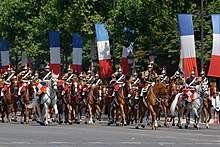
Functions and origins
Mounted bands in most cases are variants of military bands and are meant for the cavalry, and only several are in service today in various parts of the world. The main current functions have been providing musical support for ceremonial events, for civic events, and perform at military and police observances such as funerals and military and police academy graduations. Similarly to military and police, and Pipe bands, the musical repertoire is primarily based on ceremonial compositions and marches, with a high percentage also including honors music such as fanfares. A Cavalry march is used as military marching music in the movement of mounted troops. The marches of mounted bands are written in 6/8 time, rather than the 2/4 or 4/4 time of the infantry.
Mounted bands were originally established at sometime around the 12th century, during the crusades, with these newly established bands being incorporated into infantry bands. The idea then caught on in Central Europe before being used by the Ottoman Empire, who also created the first military band in the world. The use of timpani, trumpets, and bugles in these bands played an important role in the middle of the 15th century, when they were deployed to the front lines to motivate the mounted cavalry in battle and in parade.[1][2]
Mounted bands by country
Argentina
The seniormost band of the armed forces, the Alto Peru Fanfare Brass Band of the Regiment of Mounted Grenadiers, is the official mounted brass band in service to the President of Argentina in his/her capacity as Commander in Chief of the Armed Forces of the Republic. The brass band was founded in 1929. Despite it being a mounted band, it can also perform with the regiment while dismounted.
Another notable mounted band in the Argentine Army is the Mounted Band of the 4th Armoured Cavalry Regiment "General Lavalle's Cuirassiers", which wears uniforms similar to those of the French Republican Guard. Similar to the Alto Peru Band, despite it being a mounted band, it can also perform with the regiment while dismounted.
A new mounted band was raised in 2018 to serve as the ceremonial musical unit of the Mounted Operations Group of the 1st National Gendarmerie Region, Argentine National Gendarmerie.
Chile
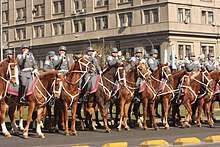
The following two Chilean mounted bands are the most notable in the Chilean Army:
- Mounted Band and Bugles of the 1st Cavalry Regiment "Guards Grenadiers"
- Band and Bugles of the 3rd Cavalry Regiment "Hussars"
Mounted band formations on parade follow the German model, having similar instrumentation with the exception being an added bugle section in place of the corps of drums of infantry units, a tradition inherited from France.
Denmark
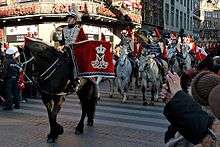
In Denmark, the Guard Hussar Regiment Mounted Squadron has a mounted band (Gardehusarregimentets Hesteskadron Trompeterkorps), which consists of one Timpani and nine bugles. The band is used for military parades, when escorting the Monarch and foreign dignitaries, and shows.[3]
Ecuador
The Mounted Band of the Ecuadorian National Police (Banda Instrumental Montada de la Unidad de Equitación y Remonta (UER) de la Policía Nacional) uses brass, woodwinds and percussion (sans the timpani). The fanfare band of the Presidential Mounted Ceremonial Squadron (Granaderos de Tarqui), also of the Army, is composed only of timpani, fanfare trumpets, a snare drum and sousaphones (when mounted).
France
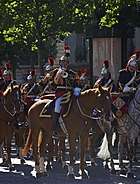
The French Republican Guard Band maintains a mounted fanfare band (La Fanfare de Cavalerie de la Garde Républicaine),which is the seniormost of its kind in the French Armed Forces. In addition to the cavalry of the Republican Guard, the Armoured Cavalry branch of the French Army and Armored Branch maintain mounted fanfare detachments for use on ceremonial occasions. All three of these bands whether mounted or dismounted feature cavalry trumpets, bugles, kettledrums and marching percussion, as well as other one handed instruments. Mounted bands began to encompass a larger instrumentation after a brief suppression by Napoleon. In the following years after, woodwind instruments were incorporated into French mounted bands.[4]
Germany
A few civilian mounted bands exist today in modern Germany. The Imperial German Army in 19th century sported many cavalry bands in its ranks before the end of the German Empire's 47 year rule in 1918. Prior to this, the most notable German mounted bands were located in the Kingdom of Prussia. Nazi Germany also sported many mounted bands during its 12-year rule. The number of mounted bands of the over 1,000 that existed in the Third Reich was alleged to be at least 138, according to some historians. Currently, a revival mounted bands is underway in the state of Lower Saxony where a brass band, the Heidedragoner Brass Band, aims to honor the traditions of the 2nd Hannover Dragoon Regiment of the Imperial German Army by having a section of the band being mounted on horses. It began this tradition in 2013 and became fully active in 2016, becoming Germany's first ever military styled civilian mounted brass band.[5]
India

The 36-member camel mounted band of the Indian Border Security Force is one of two official bands in the BSF.[6] It is the only camel mounted military band in the world, and is mentioned in Guinness Book of World Records as such.[7] It is one of the unique sights of the Delhi Republic Day parade and has been an annual participant since 1990.[8] Former Indian military mounted bands included the Gwalior Mounted Band.
Netherlands
The mounted band services are provided by the Fanfare Band of the Royal Marechaussee in the Netherlands (Trompetterkorps der Koninklijke Marechaussee). Based in Apeldoorn, the band consists of reservists and part-time musicians who work on average 2 days a week.[9] Veterans of reserve bands also hold on to the mounted fanfare and bugle band traditions of the Dutch military. The Opende based Bicycle Showband Crescendo is unique in that the civilian band is composed of musicians who are mounted on bicycles while they are playing their instruments. Currently, it is the only civilian mounted band of its kind in the world.[10] Its military counterpart is the Fanfare Orchestra of the Royal Netherlands Army Cavalry, which can also play while mounted on bicycles and wearing uniforms of the 1940s.
Oman
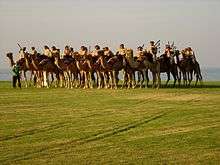
Oman currently sports what is the only camel mounted pipe band. The official name of the band is the Royal Cavalry Mounted band, and it is a unit of the Royal Guard of Oman (RGO), specifically the central band. The horses are mainly a mix of Arabs, Clydesdales and Shires. The cavalry is composed of at least 100 horses and riders, all of whom are based in Al Safinat stables at the Royal Palace. The cavalry band is probably known the most for the fact that, since 2001, it has seen a significant number of women in its ranks, with women accounting for 25% of the riders in the band. On parade, the pipers lead the band while mounted on Arab horses, as a large carriage pulled by six Friesian horses carrying drummers immediately follows behind. In 2008, Sultan Qaboos bin Said al Said of Oman requested Kilmarnock based McCallum Bagipes design some specialized pipe tubes, due to the ones at the time having a history of leaving gaps in the pipers teeth.[11][12][13]
The Royal Oman Police also maintains a camel mounted band based in Muscat.[14]
Peru
.jpg)
The Mounted Fanfare Band Company of the Presidential Life Guard Dragoons Regiment "Marshal Domingo Nieto" is today the only mounted band in active service within the Peruvian Armed Forces. It was established in 1905 along with the formation of the regiment, was disbanded in 1987 and remained inactive until 2012, when it was reactivated by Ollanta Humala, the President of Peru. It reports directly to the President as the official presidential mounted band with operational control under the commander of the 3rd Infantry Division (Army).
A small mounted fanfare band serves the Mounted Police Department of the National Police of Peru and traces its roots to the former 24th Cavalry Command of the Peruvian Civil Guard.
Portugal
The National Republican Guard (GNR) maintains a mounted band, known in Portuguese as the Charanga a Cavalo.
The Charanga a Cavalo is part of the State Honors and Security Unit (former GNR Cavalry Regiment) and usually parades with the horse squadrons of the GNR, including with Presidential Squadron in the change of the guard of the Presidencial Palace.
The Charanga a Cavalo, is the only band of its kind in the world which is able to play while galloping.[15]
Russia
In Russia, Mounted Bands (Russian: конный оркестр) existed in the Red Army in the early twentieth century. Many cavalry units sported bands that were mounted and dismounted on horses. They first have a longer history that dates back to the era of the Russian Empire. In 1867, at a competition of European military bands in Paris, the first place was taken by the Band of the Life Guards Cavalry Regiment.[16] During the latter half of the Soviet Union's existence, jubilee parades on Red Square in honor of October Revolution Day featured historical Bolshevik cavalry that were led by a mounted band with a drum major at the front.[17]
In the Russian republic of Tuva, the Brass Band of the Government of Tuva, which was created on 24 March 2008 from a student band under the Kyzyl Art College (originally founded in 1960)[18], is the only civilian mounted band in Russia, upholding the traditions of its predecessor, the Horse Brass Band of the Tuva People's Revolutionary Army, being active in the TPRA from 1929 to 1944. The first performance of the band was on horseback during a Victory Day Parade in 2008, where it received lots of enthusiasm from the residents of Kyzyl.[19] The band has been a participant in te Spasskaya Tower Military Music Festival and Tattoo[20] in Moscow and the Capital City Day celebrations in Kazakhstan.[21]
Senegal
The Red Guard of Senegal sports a mounted bands which is the premier ceremonial unit of the unit's presidential protection group. The band, which consists of 35 musical cavalrymen, leads the Red guard in parades, on their white bay horses whose tails are dyed red. It is similar to the Republican Guard Mounted Band of France and closely follows the French mounted band tradition, which includes the tradition of a bugle major.
Spain
Only the Spanish Royal Guard and the Civil Guard retain mounted bands (Banda de caballeria), which are very unique in this country that these are composed mainly of cavalry fanfare trumpets, which there are more similar in size to bugles but play differently owing to their historical role as signalling instruments for the cavalry and artillery in the Spanish Army and in the cavalry units of the Civil Guard and the current National Police Corps. The Royal Guard's Royal Escort Squadron Mounted Band of Timpani and Bugles is the only band there that has the timpani as part of its instrumentation, and is led by a trumpet major, timpani were the primary signalling instruments used in the Gardes de Corps of Napoleonic times.
Sweden
The Life Guards' Dragoon Music Corps (Livgardets Dragontrumpetarkår (LDK))serves as the official mounted band in the Swedish Armed Forces. Currently, the LDK rides at the head of the Swedish Life Guards during the mounting the King's Guard, which parades through the capital. It is closely related to the Prussian/German tradition for mounted bands and is the common basis for mounted military bands in the Scandinavian Region. The LDK is the only band that still kept their musical traditions even during the Prussian reforms of the mid-1800s initiated by Wilhelm Friedrich Wieprecht. The LDK serves under the general command of the Swedish Armed Forces Music Centre (Försvarsmusiken).
United Kingdom
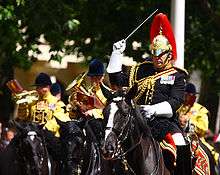
Cavalry units, like infantry battalions, maintained their own band in the United Kingdom. Until the 1930s, all cavalry regiments had a mounted band led by a drum horse.[22] Similar to the Household Division, until 2014 both the Household Cavalry regiments had their own mounted bands and also their own regimental quick and slow marches, with the merger of the regimental bands to form a unified 64-strong Mounted Band of the Household Cavalry. The term "Massed Mounted Bands" denotes the combined mounted bands of the Household Cavalry.
The current Band of the Royal Armoured Corps is a descendant of the numerous line cavalry mounted bands that existed in the 19th century and in the first half of the 20th century.
United States
Today, the United States Armed Forces does not sport any mounted bands in its ranks, although it is known, that in the first 100 years of the country's existence, mounted bands were not as uncommon as they currently are today. Establishing mounted bands in the United States in the 1840s was a very complicated process in its early years and took multiple years to assemble. This was partly due to the fact the band recruits neither knew how to ride a horse, nor knew any knowledge of how to play a musical instrument. The original bands were composed of army buglers and trumpet players, however eventually grew to include woodwind instruments and other brass instruments. Mounted bands in the United States Army were ultimately disbanded in the '30s and '40s as horses generally were replaced by mechanized vehicles such as tanks. By the end of the Second World War, there were not any ceremonial mounted bands left in the U.S.[23]
It would only be in 2019 that a mounted band would return to the US, in similar fashion as in the ongoing revival in Germany. The Ohio-based 2nd Cavalry Brigade Band, a new band made up of American Civil War reenactors playing bugles and brass instruments, was formed that spring and made its first public parade on May 29 that year, becoming thus the first ever military styled civilian mounted band. Morever, there's also a civilian mounted band, the Pendleton Roundup Mounted Band based in Oregon, that wears uniforms based on the cowboy dress of the old western communities in the late 19th and early 20th centuries.[24] This band is a full mounted band made up of brass, woodwind and percussion instrumentalists.
Uruguay
La Charanga “Grito de Asencio” Regimiento “Blandengues de Artigas” de Caballeria Nº. 1 of the Uruguayan Army is a mounted band following the Argentine practice, wearing the regiment's 19th century uniforms, but unlike its Argentine counterpart, also uses woodwinds. It is the official presidential band of the republic. Despite its mounted status, it can also perform with the regiment in dismounted formation.
See also
References
- Gleason, Bruce P. (2006). "U.S. Mounted Bands and Cavalry Field Musicians in the Union Army during the Civil War—Background, Duties, and Training". Journal of Historical Research in Music Education. 27 (2): 102–119. doi:10.1177/153660060602700204. JSTOR 25597924.
- Gleason, B.P. (2016). Sound the Trumpet, Beat the Drums: Horse-Mounted Bands of the U.S. Army, 1820–1940. University of Oklahoma Press. ISBN 9780806156521. Retrieved 29 November 2018.
- Danish Defence. "INTRODUCTION TO THE GUARD HUSSAR REGIMENT'S MOUNTED SQUARDRON" (PDF). forsvaret.dk. p. 9. Retrieved 26 November 2018.
- Musical America. 28. Musical America Corporation. 1918. p. 53. ISSN 1042-3443. Retrieved 29 November 2018.
- Gleason, B.P. (2016). Sound the Trumpet, Beat the Drums: Horse-Mounted Bands of the U.S. Army, 1820–1940. University of Oklahoma Press. p. 189. ISBN 9780806156538. Retrieved 29 November 2018.
- https://www.thebetterindia.com/39521/border-security-force-bsf-camelry-camel-band/
- https://m.timesofindia.com/city/jaipur/bsfs-camel-contingent-to-perform-at-republic-day-parade/amp_articleshow/56410186.cms
- https://books.google.com/books?id=xGYo-LPPRGUC&pg=PA29&lpg=PA29&dq=Border+Security+Force+Mounted+Band&source=bl&ots=VeztKVX_l6&sig=ACfU3U0kSaKFL1k25BKtRANFgd1CNN_g0A&hl=en&sa=X&ved=2ahUKEwiWxf6hvf3mAhUWLs0KHdo-DpcQ6AEwFXoECAEQAQ#v=onepage&q=Border%20Security%20Force%20Mounted%20Band&f=false
- "TKKmar :: The Netherlands Military Tattoo". nationaletaptoe.nl. Retrieved 29 November 2018.
- "A cycling showband from the Netherlands | Bicycle Showband Crescendo". bicycleband.nl. Retrieved 29 November 2018.
- "The Sultan Of Oman's Camel Mounted Pipe Band". Sick Chirpse. 2012-12-30. Retrieved 29 November 2018.
- "The Queen's desert cavalry jets to Windsor: 900 horses, a 10-man horseback pyramid and a mounted orchestra". telegraph.co.uk. Retrieved 29 November 2018.
- "Oman's all-female Royal Cavalry marching band takes part in Royal Edinburgh Military Tattoo | Trending News, The Indian Express". indianexpress.com. 2018-08-27. Retrieved 29 November 2018.
- Ling, Christopher (2011-03-18). Sultan in Arabia: A Private Life. ISBN 9781845968311.
- https://books.google.com/books?id=yhUkDQAAQBAJ&pg=PA194&lpg=PA194&dq=Charanga+a+Cavalo&source=bl&ots=95yv0MuVHu&sig=ACfU3U09NSSPPNp89Zp-MFeoBm2ew8S5Uw&hl=en&sa=X&ved=2ahUKEwjy54WcoaDnAhXFLc0KHeW3D6gQ6AEwEnoECAIQAQ#v=onepage&q=Charanga%20a%20Cavalo&f=false
- https://m.rusmir.media/2009/02/01/music
- https://pikabu.ru/story/muzyika_velikoy_otechestvennoy_kak_voevali_voennyie_orkestryi_krasnoy_armii_7216060?view=amp
- http://tuvaband.ru/index.php/orkestr/istoriya/171-vozrozhdjonnyj-dukhovoj-orkestr
- http://gov.tuva.ru/region/culture/1325/#:~:text=Духовой%20оркестр%20Правительства%20Республики%20Тыва%20-%20единственный%20конный%20духовой%20оркестр%20в,и%20просуществовавшего%20около%2015%20лет.
- https://spasstower.ru/participants/dukhovoy-orkestr-pravitelstva-respubliki-tyva/
- https://www.tuvaonline.ru/2014/07/14/tuvinskiy-orkestr-pokoril-astanu.html
- http://www.imms-uk.org.uk/page3.html
- "Lauderdale author's new book looks at history of horse-mounted bands". Park Bugle. Retrieved 29 November 2018.
- https://www.oregonlive.com/living/2013/09/pendleton_round-up_mounted_ban.html
External links
| Wikimedia Commons has media related to Mounted bands. |